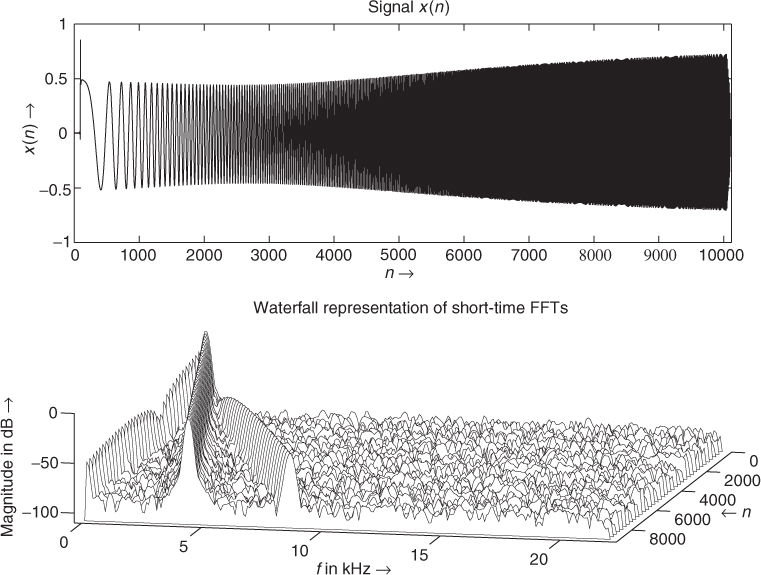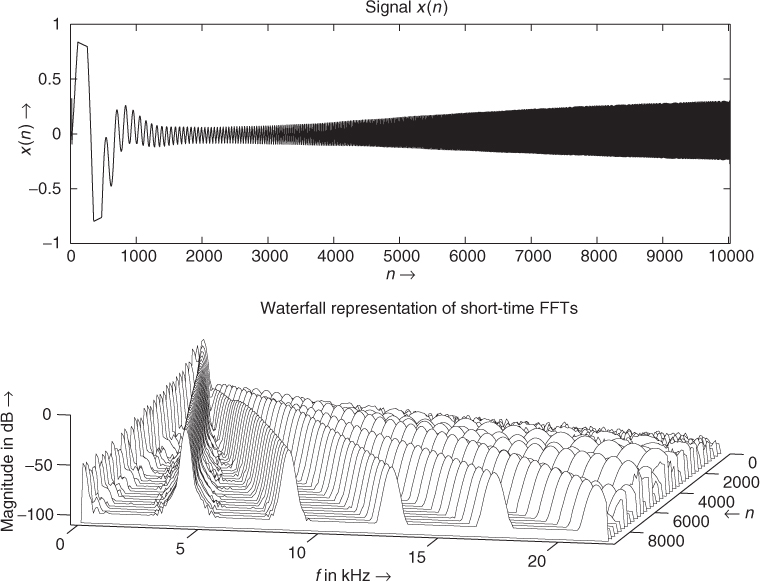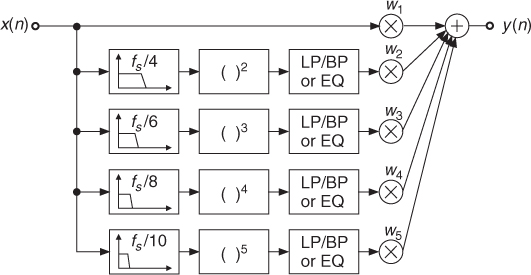4.4.1 Exciters
Introduction
An exciter is a signal processor that emphasizes or de-emphasizes certain frequencies in order to change a signal's timbre. An exciter increases brightness without necessarily adding equalization. The result is a brighter, “airier” sound without the stridency that can sometimes occur by simply boosting the treble. This is often accomplished with subtle amounts of high-frequency distortion, and sometimes by phase shifting. Usually there will only be one or two parameters, such as exciter mix and exciter frequency. The former determines how much “excited” sound gets added to the straight sound, and the latter determines the frequency at which the exciter effect starts [Whi93, And95, Dic87, WG94].
This effect was discovered by the Aphex company and “Aural Exciter” is a trademark of this company. The medium and treble parts of the original signal are processed by a nonlinear circuit that generates higher overtones. These components are then mixed to some extent to the original signal. A compressor at the output of the nonlinear element makes the effect dependent on the input signal. The initial part of percussive sounds will be more enriched than the following part, when the compressor limits the effect depth. The enhanced imaging or spaciousness is probably the result of the phase rotation within the filter [Alt90].
Signal Processing
Measurement results of the APHEX Aural Exciter are shown in Figures 4.39 and 4.40, where the generation of a second harmonic is clearly visible. The input signal is a chirp signal with an increasing frequency up to 5 kHz. Signal-processing techniques to achieve the effect have already been discussed in the previous sections. The effect is created in the side-chain path and is mixed with the input signal.
Figure 4.39 Block diagram of the psycho-acoustic equalizer APHEX Aural Exciter and frequency response.

Figure 4.40 Short-time FFTs (waterfall representation) of a psycho-acoustic equalizer.

Musical Applications
The applications of this effect are widespread and range from single-instrument enhancement to enhancement of mix buses and stereo signals. The effect increases the presence and clarity of a single instrument inside a mix and helps to add natural brightness to stereo signals. Applied to vocals and speech the effect increases intelligibility. Compared to equalizers the sound level is only increased slightly. The application of this effect only makes sense if the input signal lacks high-frequency content.
4.4.2 Enhancers
Introduction
Enhancers are signal processors which combine equalization together with nonlinear processing. They perform equalization according to the fundamentals of psychoacoustics [ZF90] and introduce a small amount of distortion in a just noticeable manner. An introduction to the ear's own nonlinear distortions, sharpness, sensory pleasantness and roughness can be also be found in [ZF90].
Signal Processing
As an example of this class of devices the block diagram and the frequency response of the SPL vitalizer are shown in Figure 4.41. This effect processor has also a side-chain path which performs equalization with a strong bass enhancement, a mid-frequency cut and a high-frequency boost. The short-time FFT of the output signal when a chirp input signal is applied is shown in Figure 4.42. The resulting waterfall representation clearly shows higher harmonics generated by this effect processor.
Figure 4.41 Block diagram of the psycho-acoustic equalizer SPL Vitalizer and frequency response.

Figure 4.42 Short-time FFTs (waterfall representation) of psycho-acoustic equalizer SPL Vitalizer.

Further refinements of enhancers can be achieved through multiband enhancers which split the input signal into several frequency bands. Inside each frequency band nonlinear processing plus filtering is performed. The output signals of each frequency band are weighted and summed up to form the output signal (see Figure 4.43).
Figure 4.43 Multiband enhancer with nonlinear processing in frequency bands.

Musical Applications
The main applications of such effects are single-track processing as a substitute for the equalizers inside the input channels of mixing consoles and processing of final mixes. The side-chain processing allows the subtle mix of the effects signal together with the input signal. Further applications are stereo enhancement for broadcast stations and sound reinforcement.
